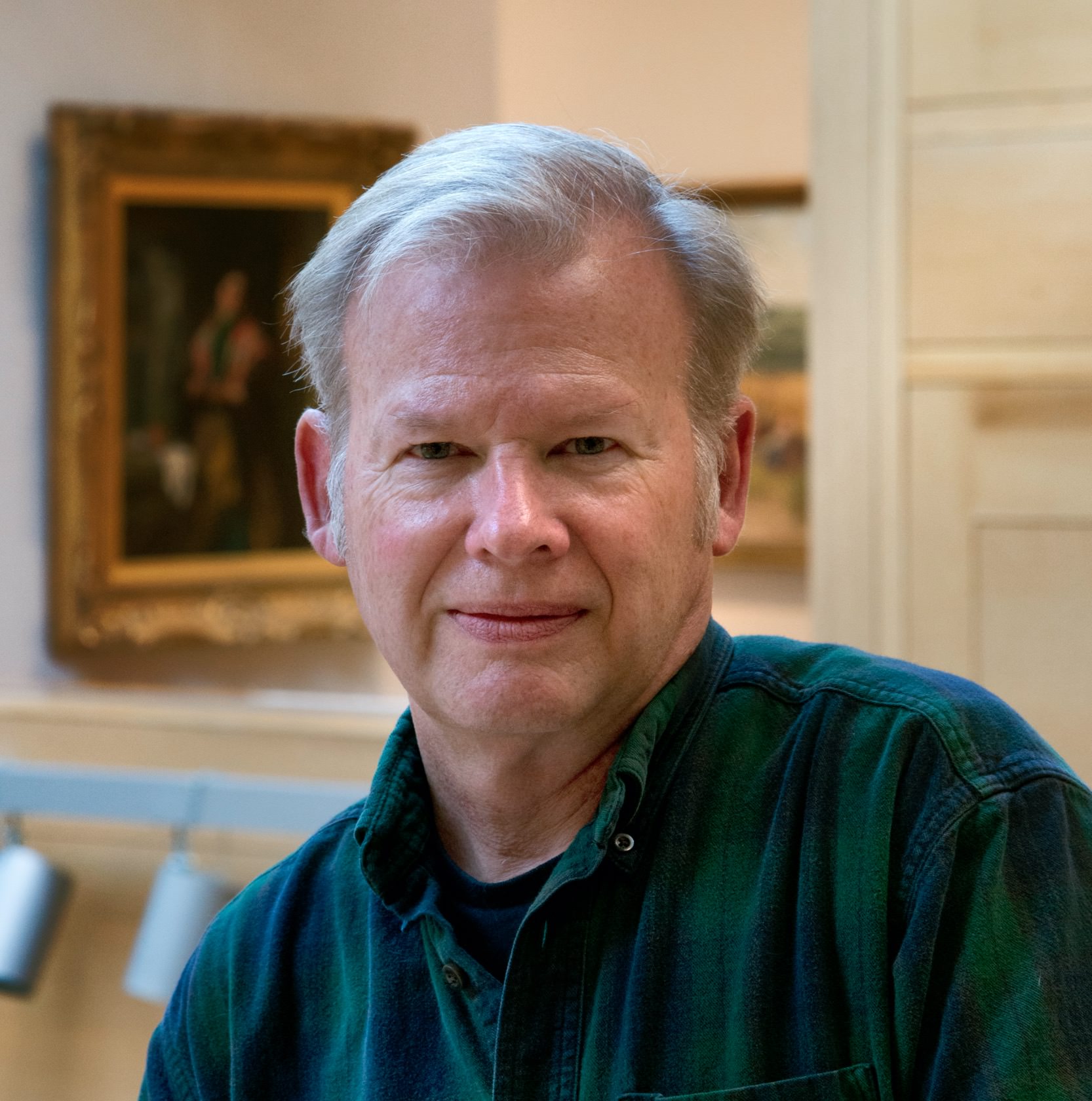Seeing Red
Seeing Red
By Glenn Adamson With photography by Richard Caspole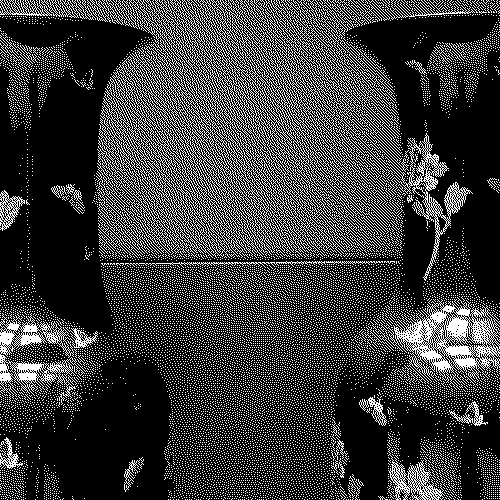
It is an invasion, of sorts: a legion of vases, each about five feet high, made of porcelain. Floridly patterned and scarlet red, they are placed throughout the Yale Center for British Art (YCBA), on every floor, in the galleries, in the library court, on the stairs. The installation, Made in China, is by the artist Clare Twomey. Its effect is most improbable, with a surreal, larger-than-life quality. It is as if caterers were about to deliver a banquet for thousands of people; or a factory floor had been teleported into the galleries; or as if ceramics were finally being recognized as a dominant genre in British art.
This last improbable thing has actually come to pass. While one could scarcely have predicted it a decade ago, the long-neglected medium of ceramics has finally come into its own. Edmund de Waal and Rebecca Warren are among Britain’s best-known artists. Grayson Perry—who leapt to the front of the queue some years ago, partly by mocking his own status as a humble potter so devilishly—is now a widely beloved figure. It is true that there remains a distinction between functional pottery and ceramic sculpture, but the opposition has come to be an animating theme rather than an impassable barrier. Tate St Ives recently staged an offbeat exhibition titled That Continuous Thing, which traced an eccentric arc from Bernard Leach through modernist sculpture and on to self-consciously amateur experimentation. While the show did not have an argument, exactly, it left no doubt that status-based hierarchies have been fully dismantled.
Twomey’s Made in China is only one (albeit a major) element within Things of Beauty Growing: British Studio Pottery, a comprehensive survey exhibition of the ceramic vessel form, co-curated by Martina Droth of the YCBA, Simon Olding of the Crafts Study Centre, and myself. The show’s narrative includes past moments when potters had names to conjure with—Bernard Leach, William Staite Murray, Michael Cardew, Lucie Rie, and Hans Coper. The intention is to bring their accomplishments back to the fore, while also demonstrating the possibilities for ceramics in the present day.

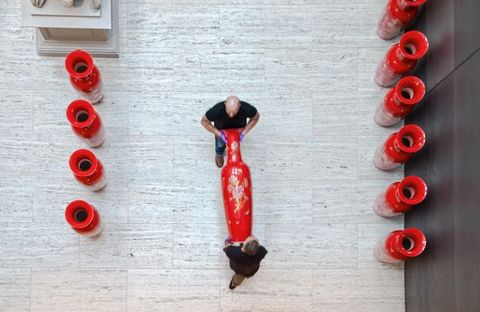
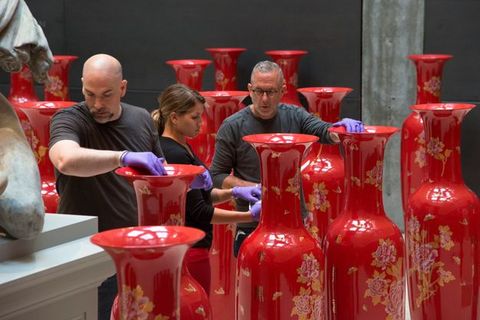

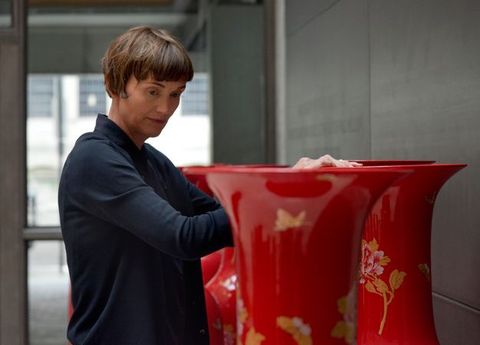
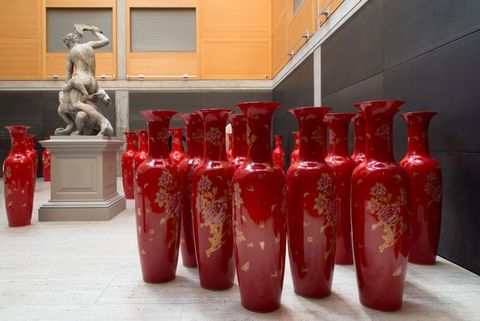
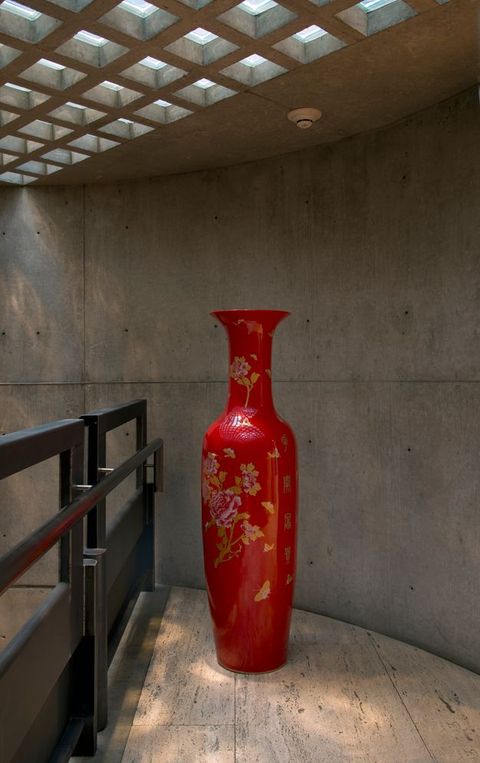

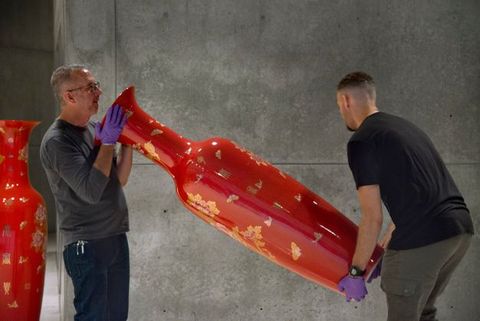
There are many reasons for the recent embrace of ceramics, among them a general permissiveness regarding artistic disciplines, and a rediscovery of the instinctive, sensually gratifying nature of clay. Perhaps the most important, though, is that ceramics are good to think with—particularly regarding issues of labour. This topic is at the heart of Twomey’s work, which illuminates the asymmetrical nature of global economic exchange. The eighty vases that comprise Made in China were, as the title implies, manufactured in Jingdezhen, long the world’s greatest ceramics centre. The particular facility that produced them, though extraordinary in its capabilities, is actually quite typical for the city; Twomey identified it through a simple Google search. She purposefully avoided any direct involvement in the making, wanting the process to be at arm’s length, like any other order from a Chinese factory.
All but one of the vases were decorated in Jingdezhen with inexpensive decals, but the eightieth vase was shipped to the Royal Crown Derby factory in Stoke-on-Trent. There it was hand-gilt in 18k gold with a pattern of sinuous chinoiserie dragons. Amazingly, the cost of this decoration was equivalent to the entire production cost of the other vases combined (a fact that helps to explain why British ceramic manufacturing has cratered in the past few decades). Visitors to the YCBA are encouraged to wander through the maze of the work, searching out the one “special” vase. When they find it, perhaps they will recognize it as a portrait of Royal Crown Derby and other firms like it: the precious remnant of a once-great industry.
Twomey sometimes describes herself as a “post-studio” artist. Though a specialist in ceramics, she rarely touches wet clay herself, instead asking others to execute her ideas. This also applies to the installation of Made in China at Yale, which was quite literally the work of many hands. For a visitor, the vases may seem to have appeared by magic, but in fact, the museum’s crew devoted the better part of a week to the installation. This was highly skilled, delicate work. As each vase was carefully positioned, it was carried by teams of two, fixed in place with wax, and then weighted to prevent tipping. Ingeniously, the art handlers devised a bespoke system involving strings of small handmade sandbags, which could be dropped down the neck (a single solid weight would have been very difficult to remove at the conclusion of the installation). It is important to recognize this professional labour, which mirrors that of the Chinese fabricators, who created the vases.
As often happens with powerful works, Made in China has acquired additional valences of meaning since it was made. Looking at the work in 2017, a reality reshaped by Brexiteers and the paranoid rage of Trump, the antiquated racist phrase “red menace” springs to mind. Twomey’s work faces up to such emotional intensity. While in some sense “proper”, echoing as it does the garnitures of stately country houses (something that would have been even more apparent in a previous installation of the work at the Harley Gallery in Welbeck Abbey, Nottinghamshire), it also possesses an unmistakable aggression. The blood-red colour and the overwhelming quantity suggest ranks of soldiers, echoing the famous terracotta army of the ancient Chinese emperor Chin Shi Huang Ti. The undercurrent of threat is more palpable than ever in the installation at Yale, where the shining scarlet surfaces contrast dramatically with Kahn’s muted palette of concrete, oak, and travertine. It so happens that John Cheere’s imposing sculpture in lead, Samson Slaying a Philistine, towers above the vases in the grand entrance. The great classical figure, jawbone in raised hand, appears almost to be defending his sacrosanct domain against invasion.
Yet it is important to remember that for many viewers, particularly those who are from China or know something of its culture, all these associations may well be absent. Bright red denotes not violence in Chinese culture, but well-being. The colour of the vases is that of cinnabar lacquer, festive paper decorations, wedding dresses, and of course, the national flag. The peonies that ornament the vases are also auspicious—the flower connotes “wealth and honour” (fuguihua)—and the inscription on each conveys wishes for prosperity and good luck. Thus, what might be read as threatening or simply surrealistic, from a Euroamerican perspective, is from the Chinese point of view symbolic of abundance and generosity.
The point here is not that one of these readings is wrong-headed, and the other correct. Rather, we should understand Made in China as a meditation on global culture. The duality of the work, its emotional instability, and its sheer unexpectedness: all of these capture what it means to live with difference. In an age darkened by nativist politics, Twomey gives us an image of what it means to confront the “Other”. Even if cultural encounter is uncomfortable, even if it destabilizes whole ways of life, it is that dynamic movement—not static national identity—which truly defines us.
About the authors
-
Glenn Adamson is a curator, writer, and historian based in New York. He has previously been Director of the Museum of Arts and Design; Head of Research at the Victoria and Albert Museum, London; and Curator at the Chipstone Foundation in Milwaukee. Adamson’s publications include Thinking Through Craft (2007); The Craft Reader (2010); Postmodernism: Style and Subversion (2011), accompanying the exhibition of that title at the V&A, co-curated with Jane Pavitt; The Invention of Craft (2013); Art in the Making (2016), co-authored with Julia Bryan-Wilson; and Fewer Better Things: The Hidden Wisdom of Objects (2018). His newest book is Craft: An American History, published by Bloomsbury.
-
Richard Caspole is the Senior Photographer for the Yale Center for British Art, New Haven, CT. A graduate of Paier College of Art, he has been photographing art, historical objects and architecture at Yale University for 37 years.
Imprint
| Author | |
|---|---|
| Date | 30 November 2017 |
| Category | Curatorial Essay |
| Review status | Peer Reviewed (Editorial Group) |
| License | |
| Downloads | PDF format |
| Article DOI | https://doi.org/10.17658/issn.2058-5462/issue-07/gadamson |
| Cite as | Adamson, Glenn, and Richard Caspole. “Seeing Red.” In British Art Studies. London and New Haven: Paul Mellon Centre for Studies in British Art and Yale Center for British Art, 2017. https://doi.org/10.17658/issn.2058-5462/issue-07/gadamson. |

